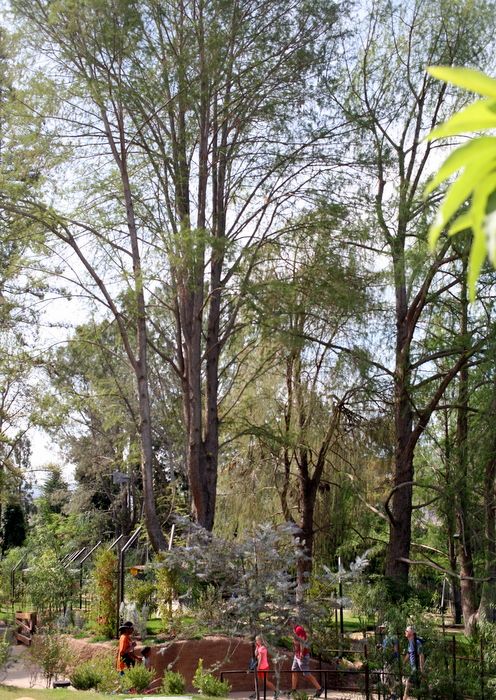So friends and/or relatives are visiting you in Southern California, and you’re sorting through which tourist destinations will please everyone, of all ages and dispositions (even your own sweaty and cranky self at the thought of hitting tourist spots). Do yourself a favor and throw out this suggestion: San Diego Zoo Safari Park.

And you won’t be entirely selfish in making this suggestion. Because everyone loves giraffes (including this rare push-me/pull-you subspecies). And seeing them move unmolested over wide open spaces, grazing alongside all their antelope and wildebeest friends, is a surefire crowd pleaser. David, your tram driver and guide, will urge you to observe the canopies of the trees as you rumble along in the tram, each canopy identical in height from the ground as though sheared by an overzealous OCD grounds keeper– but which in fact reflects the uppermost reach of the grazing giraffes. It is an enthralling scene.

But the sneaky part about voting for visiting the park is the fact that, for the botanically inclined, it’s nirvana. The botanical richness includes the largest collection of boojum trees (Fouquieria columnaris), outside their native habitat in Baja California. In our case, none of us were out-of-towners, just enthusiastic locals. We were guests of family, Duncan and Kristy, members of the Safari Park. Cardóns (Pachycereus pringlei) rising up like saguaros behind them complete the feeling of being in Little Baja.

The stout quiver trees on the left (Aloidendron dichotomum), are of course from Southern Africa.

Stay alert because the botanical show is scattered through the park. The Fever Tree or Yellow-Barked Acacia, A. xanthophloea, is near the entrance, but there are many more throughout the park. Nothing is labeled, so it’s a bit of a scavenger hunt, and thankfully there’s not a trace of the floral-heavy public-planting syndrome. The plantings are suitably naturalistic.

It will be hot in summer, but the grounds are so thickly planted that shade is never far away. Hats, drinks, and sensible shoes are de rigueur, as in any summer outing. Misters are set up at various sites throughout the park, both to cool visitors and make the Sumatran tigers feel right at home.

Moreton Bay Fig? It’s adjacent to the pavilion where we caught the falconry show.

Our little group moved at a snail’s pace through the park, arrested at every turn by some spectacular plant or animal, but nevertheless we covered miles on foot. We never did get to see the elephants even though we arrived at 9 a.m., when the park opened. The tram ride was the final flourish to our visit, and we left the park around two o’clock to be back in Los Angeles for dinner. But the park is open until 7 p.m., and it’d be magical to experience twilight here.

Bottle tree (Brachychiton rupestris) and aloe.

Wollemi pine

In the new exhibit, Walkabout Australia, Australian plants are densely showcased.

This is not only thematic botanically but also because this is what the animals from Oz want to eat. (I can’t place which buttonbush that is in the right foreground, but there were loads of callistemons, banksias, and of course eucalyptus including ‘Moon Lagoon.’)

And there is an enormous bonsai pavilion that appears to be quite new.

The nonprofit Safari Park, which takes up thousands of acres, was started some 40 years ago as the breeding arm of the San Diego Zoo and is entirely reliant on donor and visitor support. Currently among their challenges is finding a way to breed their Southern White Rhino with the last two female members of the Northern White Rhino. (The last male Northern White Rhino died this past March, under guard in an animal sanctuary in Kenya, so the species is now functionally extinct.) To finance conservation efforts, the park has hit upon a great combination of sights and activities — zip lines, hot air balloon rides, elevated rope trails, not to mention the cycads, bamboo tunnel and enormous Bismarckia palms…as I said, something for everyone.

I knew it as the Wild Animal Park. As the name changed in 2010, that means it’s been a long time since I’ve been there. However, it was great then and it looks great now. As I recall, the plants at the San Diego Zoo were impressive too but then I haven’t been there in many years either, although the sight of a baby hippo being born in the pool during my last visit is indelibly etched in my memory. Interesting about the addition of zip lines at the Safari Park – a friend of mine once suggested that South Coast Botanic Garden add them as revenue drivers there.